Jacaranda Tree: Flowers, Leaves (With Pictures) – Care and Identification Guide
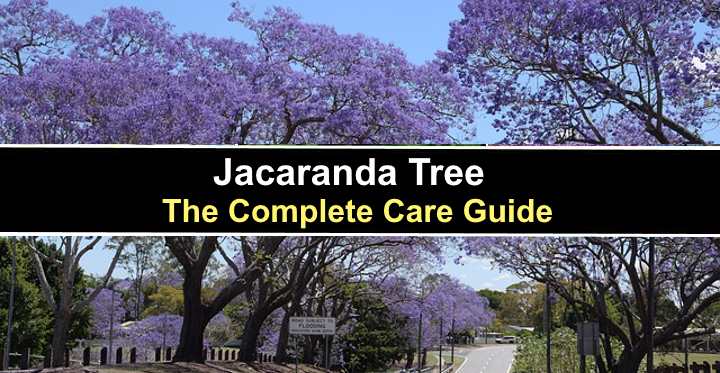
Jacaranda mimosifolia is a beautiful ornamental tropical tree. The jacaranda tree is known for its spectacular clusters of intense purple-blue trumpet-shaped flowers, attractive green fern-like leaves, and a spreading umbrella-like canopy. Also called the blue jacaranda, the stunning flowering tree is native to South and Central America and popular in Florida and California. The fast-growing elegant jacaranda tree with its blue flowers is common in streets, parks, and gardens as it blooms in spring and summer.
This article is a comprehensive guide to growing and caring for a jacaranda mimosifolia tree. Descriptions and pictures of the jacaranda tree’s flowers, leaves, and bark will also help identify this popular semi-tropical tree. At the end of the article, you’ll get helpful tips on resolving issues growing the jacaranda tree.
Blue Jacaranda (Jacaranda mimosifolia)
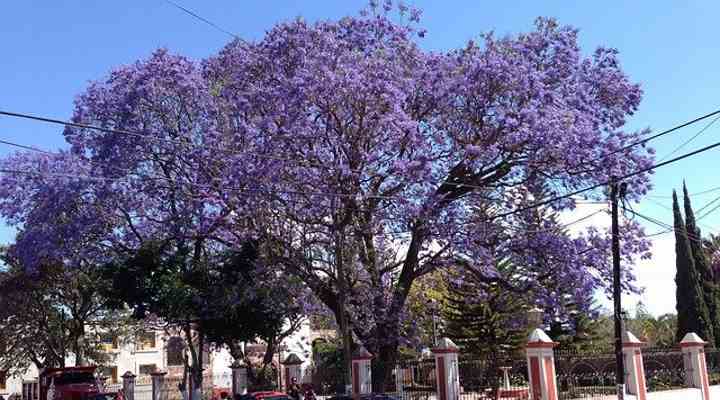
Blue Jacaranda (Jacaranda mimosifolia)
The blue jacaranda tree is described as a tree of intense beauty. Jacaranda tree is a semi-evergreen tree that grows 25 to 50 ft. (7.5 – 15 m) tall and has a spreading rounded crown of 15 to 30 ft. (4.5 – 9 m). The Jacaranda mimosifolia has upright branch growth with an open habit.
The blue jacaranda tree is a stunning specimen tree, suitable for medium to large yards. Thanks to its beautiful dark green pinnately compound leaves, the tree is useful as a lawn or tree to enjoy dappled shade beneath its spreading canopy.
In the United States, blue jacaranda trees thrive in southern states. The stately blue-flowering tree is popular in Florida, Texas, and California. The medium-sized flowering tree turns landscapes into beautiful hues of blue, lilac, and light purple.
Other names for Jacaranda mimosifolia include blue jacaranda, green ebony, fern tree, sharp-leaf jacaranda, and black poui.
When planting a jacaranda tree, one thing to think about is that it tends to be messy. After flowering, brown woody seedpods develop that contain winged seeds. These can cause a lot of fall clear-up from patios, driveways, pools, and lawns.
Jacaranda Tree Growing Zone
Jacaranda trees are semi-tropical southern trees that thrive in USDA zones 10 and 11. The flowering trees perform best in full sun, and prolific flowering happens away from coastal regions. You may also have success growing a blue jacaranda tree in warmer areas of growing zone 9b.
Jacaranda Tree Growth Rate
The jacaranda tree has a fast growth rate. Planted in optimal conditions, the stunning flowering jacaranda tree grows about 10 ft. (3 m) during its first year. After that, jacarandas grow about 20” (50 cm) per year and mature between 25 and 50 ft. (7.5 – 15 m) tall.
Jacaranda trees can live up to 70 years, adding beauty and color to their surrounding environment. In warm areas in the southern US, its fast growth, medium size, and sprawling canopy mean you can quickly enjoy its benefits as a residential shade tree.
Jacaranda Tree Flowers
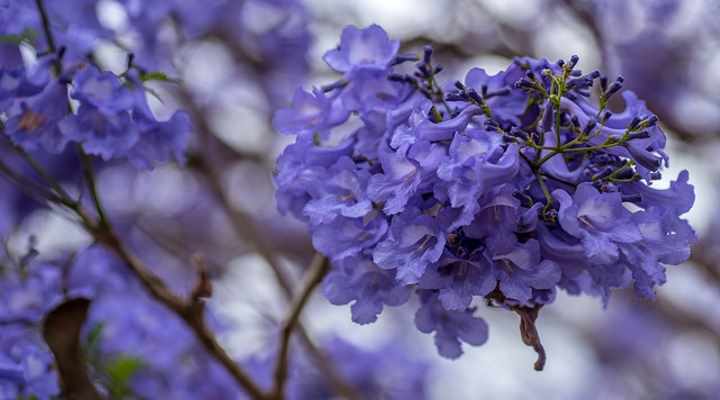
Jacaranda tree with purple-blue flowers
Jacaranda trees have blue trumpet-shaped flowers that are usually arranged in clusters. Individual tubular flowers measure around 2” (5 cm) long, and the showy blue or lilac panicles grow up to 8” (20 cm) long. The blue jacaranda flowers usually appear in late spring and early summer and last for two months.
The common name, blue jacaranda, refers to the flower clusters’ typical light blue to dark lilac color. However, jacarandas can also produce very pale blue blooms that appear white. In the warmest areas, jacarandas may bloom throughout the year.
The cultivar Jacaranda mimosifolia ‘Alba’ is a tropical tree with white flowers.
Unfortunately, small jacaranda trees or those grown indoors in containers rarely—if ever—bloom.
Jacaranda Tree Leaves
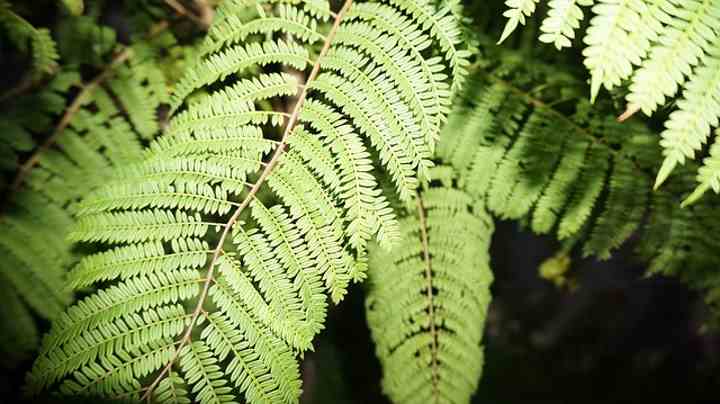
Jacaranda tree leaves
Jacaranda tree leaves are fern-like and are bi-pinnate, meaning they are composed of major leaflets along the midrib, while each major leaflet has smaller leaflets. Each leaf can reach up to 20″ (50 cm) long. The green leaves turn brown in autumn.
Jacaranda Tree Fruit (Seed Pods)

Jacaranda tree fruit (seed pods)
Blue jacaranda trees produce fruit in the form of mahogany-colored woody seedpods. The round brown seed pods measure 3” (7.5 cm) wide and appear on trees in late summer. The plate-like pods open like clams to reveal several winged seeds in papery casings. The seeds are collected for their decorative value.
Jacaranda Bark
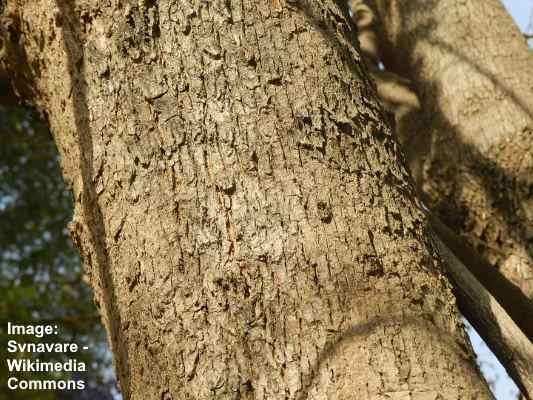
Jacaranda bark
Bark on jacaranda trees is a grayish-brown color and relatively thin and delicate when the tree is immature. The tree bark takes on a finely scaly appearance and texture as the tree matures. Jacaranda tree branches have a curving appearance, and the twigs have a zig-zag shape.
Jacaranda Tree in Florida
Jacaranda trees are common flowering trees in Florida landscapes. The heat-loving jacaranda tree thrives in the humid environment of Central and South Florida. As a result, you will often see the purple-flowering trees in the Sunshine State in parks, streets, and yards south of Orlando through to the Florida Keys.
Jacaranda Tree Lookalikes
Jacaranda trees are easy to mistake for other evergreen trees with double pinnately compound leaves like the yellow flame tree (Peltophorum pterocarpum) or royal poinciana (Delonix regia). From late fall until early spring (when the trees are not flowering), it is virtually impossible to tell jacaranda apart from other look alike ornamental trees.
Yellow Flowering Jacaranda Tree Look-Alike
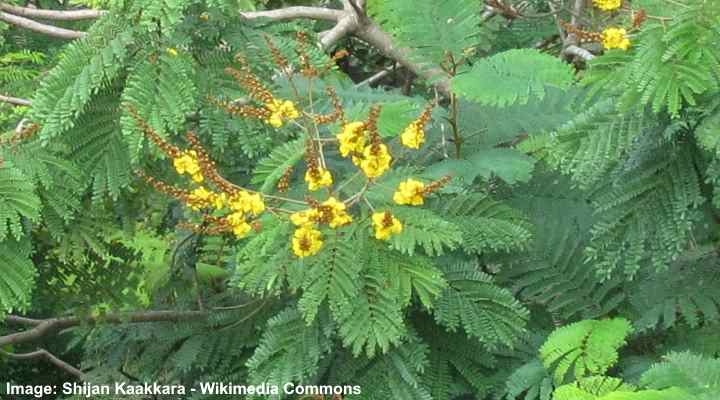
Yellow flame tree (Peltophorum pterocarpum)
The yellow flame (Peltophorum pterocarpum) tree looks like a yellow-flowering jacaranda tree. The attractive evergreen southern tree also has fern-like foliage and a beautiful rounded canopy. However, the jacaranda tree only blooms with light blue to lilac flowers, not bright yellow blooms like the yellow flame tree.
Red Flowering Jacaranda Tree Look-Alike
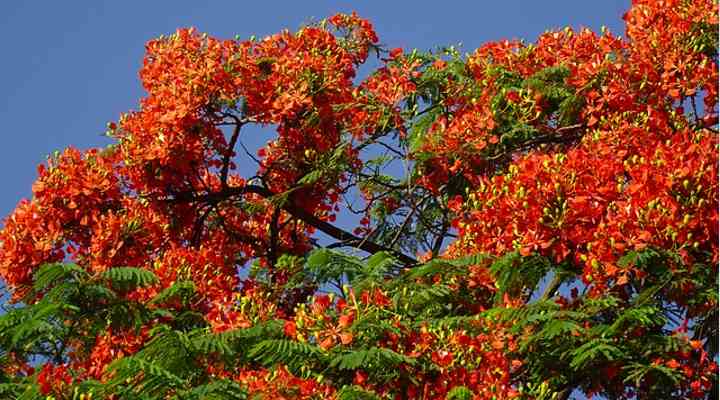
Royal poinciana (Delonix regia)
The royal poinciana (Delonix regia) tree looks like a red-flowering jacaranda tree. Like other jacaranda tree look-alikes, the tropical royal poinciana has leaves that look like fern leaves and a spreading umbrella-like canopy. However, the difference between the two trees is the color of the flowers. The royal poinciana has red flowers, not blue blooms.
Jacaranda Tree Identification
The identifying feature of the jacaranda tree is its showy lilac-blue flower clusters that bloom in the late spring or early summer. The fast-growing jacaranda tree has gray-brown, finely scaly bark, brown circular seed pods, and an easily recognizable umbrella canopy covered in pinnately compound, fern-like leaves.
Dwarf Jacaranda (Bonsai Blue)
The dwarf Jacaranda (Jacaranda mimosifolia ‘Bonsai Blue’) is a stunning small tree that produces vivid blue-purple flowers. The ornamental tree grows 5 ft. (1.5 m) tall and has all the features of the larger tree. In addition, the dwarf jacaranda ‘Bonsai Blue’ has light-green fern-like leaves, clusters of tubular bluish flowers and is suitable for small, compact yards.
The dwarf jacaranda tree has many hardier qualities than the larger species. The small flowering dwarf jacaranda tree grows well in containers and survives temperatures as low as 28°F (-2°C). In addition, the tree has breath-taking purple blooms, soft fern-like foliage, and is relatively tolerant of drought.
Where to Plant Jacaranda Tree
Jacaranda trees thrive in warm, humid climates and perform best growing in full sun. When deciding where to plant the subtropical tree, choose the sunniest spot in your yard. It is also vital to plant the tree at least 15 ft. (4.5 m) away from any buildings.
It’s good to remember that jacaranda seedlings won’t grow in the shade of other trees.
The planting location for a jacaranda tree should be in fertile, rich loamy soil that drains well. Therefore, if your yard has poor quality soil, you will need to amend the soil with plenty of compost before planting it. This way, you ensure that the ground has enough nutrients to support healthy growth.
How to Plant Jacaranda Tree
The best time to plant a jacaranda tree is between late fall and early spring.
It’s crucial to think about space before digging a hole to plant a jacaranda seedling or rooted nursery tree. A jacaranda tree grows rapidly and reaches 25 to 50 ft. (7.5 – 15 m) tall and 30 ft. (10 m) wide in a few years. Planting in crowded spaces will result in weak growth.
To plant a blue jacaranda tree, start by digging a hole the same depth as the root ball and twice as wide. Next, place the root ball in the hole and backfill with organic-rich native soil. Ensure that the base of the jacaranda tree’s trunk is about 1” (2.5 cm) above the soil level. Press the ground down as you go to eliminate any air pockets.
Then you should create a mound of soil about 3” (7.5 cm) tall and 30” (76 cm) in diameter around the trunk. Next, thoroughly water the newly-planted jacaranda tree, ensuring the root area is well irrigated.
For the last step, spread a 2” (5 cm) layer of lightweight organic mulch over the jacaranda tree root area to help keep the ground moist and prevent weeds from growing. During the first season, water the soil once a week to help the root system get established.
How to Grow Jacaranda Tree From Seed
It is straightforward to grow a jacaranda tree from seed. First, pick the jacaranda seedpods directly from the tree when brown and dried for best success. Then at home, open the brown, round jacaranda seedpods like opening an oyster’s shell and remove the seeds. You are now ready to prepare the seed for planting.
First, soak the jacaranda seeds in water for 24 hours. Next, get some 4-inch (10 cm) pots filled with a moist, well-draining potting mix. Then push one jacaranda seed into the middle of each pot about 0.5” (1.3 cm) deep. After that, place a plastic bag over each pot and secure it with a rubber band to lock in moisture. This creates a humid atmosphere to encourage germination.
It takes two to three weeks for jacaranda seedlings to appear. Keep the seedlings growing in their pots until the following spring, and then transplant them to your garden.
Growing Jacaranda Tree in Containers
Jacaranda trees can grow in containers,which is useful if you live in USDA growing zones 9 and below. You will need a 5 gallon (19 l) container with drainage holes in the base, a loamy potting mix, and a healthy nursery plant.
Place the potted jacaranda tree in a sunny spot in your garden where it gets six to eight hours of sunlight daily. Water the plant regularly whenever the top 2” (5 cm) layer of soil is dry. You may need to water the tree every other day in hot weather. Bring indoors when the nighttime temperature drops to 40°F (5°C).
Potted jacarandas don’t grow well indoors throughout the year. So, keep them outdoors from late spring until early fall in temperate climates. It’s also a good idea to refresh the compost yearly to provide the soil with plenty of nutrients.
Jacaranda Tree Care Guide

Jacarandas are relatively easy to care for in southern climates. The tree thrives when it gets plenty of heat, sunshine, and water. However, it’s vital to avoid overwatering the tree; otherwise, it could suffer from root rot and foliar fungal diseases.
How to Water Jacaranda Tree
Water a blue jacaranda tree once a week in the growing season and less often in winter. Jacaranda trees perform best in evenly moist, well-drained soils. Therefore, you should water the root area regularly and ensure that you don’t allow the soil to dry out.
The best time to water a jacaranda tree is when the top layer of soil is dry. To water the tree, you should provide deep watering to the root area, concentrating around the edge of the drip line, not close to the trunk. To ensure the ground is sufficiently moist, check that at least 3” (7.5 cm) of soil is damp.
Although once a week is recommended for watering jacaranda trees, you may have to water it every other day during intensely hot or arid periods. Water about once a month from late fall until the end of winter.
Fertilizing Jacaranda Tree for Healthy Growth
A jacaranda tree benefits from annual fertilization using a balanced tree fertilizer. You can use a slow-release fertilizer with an NPK rating of 10-10-10. Follow the manufacturer’s instructions with the amount of fertilizer to use.
When it comes to fertilizing a blue jacaranda tree, here are a few tips:
- Don’t provide too much nitrogen, or the tree may not produce plenty of blue flowers.
- If the tree is growing near a fertilized lawn, you don’t need to provide additional fertilization.
- Digging in a good amount of rotten manure in the spring is an excellent alternative to chemical fertilizers.
Pruning Jacaranda Tree
It would be best if you only pruned an immature jacaranda tree to form the main trunk or central leader. However, an established or mature jacaranda tree doesn’t require pruning to keep its shape or encourage growth. Annual removal of dead or diseased branches in late winter is all the pruning the tree needs.
Jacaranda Tree Propagation
Growing a jacaranda tree from a softwood cutting is faster than growing the tree from seed. In early spring, you can take a 6” (15 cm) cutting from branch tips that contain a few healthy buds and at least three nodes. Put the cutting in a jar of water and wait until roots appear (about two weeks).
Once the cutting has roots 1” (2.5 cm) long, you can transfer the rooted cutting to a pot containing a well-draining soilless potting mix. Put in a sunny, warm location and let the cutting grow and develop for at least eight months. After that time, you can transfer the young tree to your garden or a 5-gallon (19 l) container.
Pests and Diseases Affecting Jacaranda Tree Growth
Pests rarely infest jacaranda trees that are well-watered and growing in full sun. Typically, bean aphids and scale insects are the only problems affecting the trees. However, they rarely do enough damage to affect the tree’s growth.
Bean aphids (Aphis fabae) are black bugs covering the jacaranda tree’s foliage and stems. The pesky aphids bite into the soft plant tissue and damage the foliage by sucking the juices. You may also notice sticky amber honeydew and increased ant activity around the tree. Use the garden hose to dislodge the bugs.
Related reading: How to kill aphids on outdoor plants.
Scale insects on jacaranda trees are challenging to spot because they look like discolored bumpy growths on branches. Usually, you don’t have to worry about scale. However, you can get some tips on how to remove scale insects.
Glassy-winged sharpshooters are pests that carry the lethal disease Xylella fastidiosa. The bugs infect the tree when they feed on foliage. The bacteria they spread leads to scorch disease by blocking water that passes through the branches to the leaves. Unfortunately, there is no cure, and the tree will eventually die.
Mushroom root rot is a potentially lethal disease that can cause jacaranda trees to die. The pervasive fungal infection is caused by overwatering or poorly draining soil. You will notice this disease by peeling bark that reveals a white fungal growth underneath.
Related articles:
